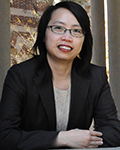2011, 2014
Sonya S. Lee
- Associate Professor
- University of Southern California

Abstract
Cave temples are a unique architectural form that transforms a mountain into a place for religious activities through the installment of pictorial images and other artifacts. This study explores what it meant to integrate cultural practices like these into a natural environment in Sichuan province of China. The region boasts a diverse tradition of cave-building since the seventh century, thus offering a wealth of materials to examine the technologies, mindsets, and aesthetic sensibilities that have fueled the enduring allure of these spaces between culture and nature. By adopting an ecological approach to the analysis of representative sites, a history of cave temples in Sichuan will contribute to critical debates in art history, architecture, history of religion, and environmental history.
Abstract
Since its inception in early modern Europe, the museum has provided nation-states with a powerful tool to display and define their own cultures and those from around the world. This international symposium, which will be held at the University of Southern California and the Los Angeles County Museum of Art, takes the museum as the critical lens through which to examine the collecting and display of Asian art in relation to conceptualizations of Asia that gained currency in the cultural and geopolitical milieu of modernity. The dual focus allows for in-depth inquiries into interregional and intraregional connections that manifested in the workings of the art market, museological practices, and art-historical discourses across Europe, the Americas, and Asia from the nineteenth century to the present day. The presenters at this event collectively aim to explicate how ideas of Asia contributed to the development of specific museum collections, and conversely, how museums helped generate new ideas about the continent in the public domain through exhibition, education, and research. Key questions regarding the rise of the museum as a space of cultural production will be considered: How did an assemblage of objects represent a culture? Why was it necessary to frame the representation of a country in relation to that of a region? In what ways did object types affect the decision to include and/or exclude particular cultures in an assemblage? Who were involved in determining the cultural meanings of these objects, and who were the audiences?

